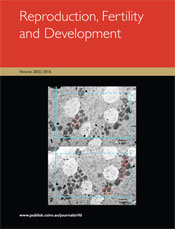Reproduction, Fertility and Development
Volume 28
Number 5 2016
The Wnt family of secreted ligands plays a major role in regulating a wide range of biological processes, including reproduction. This review summarises our present knowledge of the expression, regulation and function of Wnt signalling pathways in early pregnancy and placentation. Knowledge in this area has applications in the diagnosis, prevention and treatment of infertility and gestational diseases.
Putative effects of whole-body heat exposure include changes in testicular cells and spermatozoa. This study compared laboratory mice exposed to whole-body heat to control mice. The results show reduced testis weights and damage to developing and formed spermatozoa. These changes can cause male infertility. The results from this study could be extrapolated to humans exposed to high temperatures in their occupations.
Sex-sorted spermatozoa can play a crucial role in enhancing genetic improvement and production efficiency in swine industry. The presence of a high proportion of seminal plasma in semen samples negatively influences sperm sex-sorting efficiency. Removing the seminal plasma before sorting can reverse the consistent poor sperm sortability exhibited by the ejaculates of some boars.
This work provides evidence of the functional interaction between the endocrine and peripheral neural systems. The aim was to study the effects of prolactin added to the coeliac ganglion, via the superior ovarian nerve, on ovarian physiology at the end of rat pregnancy. Prolactin acts at the coeliac ganglion and sends information to the ovary by a neural pathway, modifying parameters of functional and structural luteal regression.
Leptin had effect on capacitation and acrosome reaction in human and swine spermatozoa. In this study, for the first time, mRNAs for leptin and its receptors, and their corresponding proteins were detected in equine spermatozoa. When leptin was used in our in vitro fertilisation model, results show that leptin is involved in capacitation and hyperactivation of equine spermatozoa but not in spermatozoa penetration.
Prepubertal pig oocytes, used for the production of transgenic pigs as human disease models, have low developmental competence. The aim of this experiment was to describe oocyte ultrastructure and to quantify mitochondria in pre- and postpubertal pig oocytes. The ultrastructure and higher number of mitochondria in large pre- and postpubertal oocytes was compatible with higher developmental competence.
Changes in intracellular concentrations of Ca2+, hardening of the zona pellucida, parthenogenetic activation and embryonic development following IVF were evaluated in feline oocytes after exposure to three common cryoprotectants. A combination of DMSO and propanediol had minimal effects on the viability of feline oocytes and may be useful for the development of more efficient protocols for vitrification of feline oocytes.
Leukemia inhibitory factor (LIF) and Oncostatin M (OSM) play important roles during implantation and placentation. This study aims to compare responses on LIF and OSM in four different trophoblastic cell lines. In all, LIF and OSM induce STAT3 and ERK1/2 phosphorylation, while only LIF significantly increases trophoblast cell invasion. Thus, both factors have similar but not identical funtions in placentation.
The progesterone receptor membrane components 1 and 2 (PGRMC1, PGRMC2) may be a part of the mechanism by means of which women come into labour despite continued high progesterone concentrations. Expression of PGRMC1 mRNA and protein was found to be significantly lower in myometrium from women in labour. This change may be mediated by microRNA species hsa-miR-520e.
The ability to derive, expand and cultivate avian primordial germ cells (PGCs) without altering their biology is a prerequisite for germplasm-based avian genetic preservation and engineering purposes. We describe original and robust methods that allow long-term expansion and cryobanking of primary cultures of PGCs without obvious effects on their biological properties or their ability to colonise the genital ridges. This provides an alternative access to applications in avian biotechnology and preservation of genetic resources.
There is growing concern that obesity is negatively impacting health of many species – including the world’s largest land mammal – the elephant. This study provides the first evidence that poor reproduction in zoo African elephants is related to excessive body fat and altered levels of obesity-related hormones. Promoting weight loss in non-cycling females with the goal of improving metabolic health and resumption of ovarian activity may combat the non-sustainability of zoo African elephant populations.
Identifying the abnormalities in spermatozoa of infertile men may aid in the development of new interventions for infertility. This study reveals that infertile men with varicocele have lower omega-3 fatty acids levels and greater oxidative DNA damage in their spermatozoa. The findings highlight the need for intervention trials to test the usefulness of omega-3 supplementation in reducing sperm abnormalities in infertile men with varicocele.




